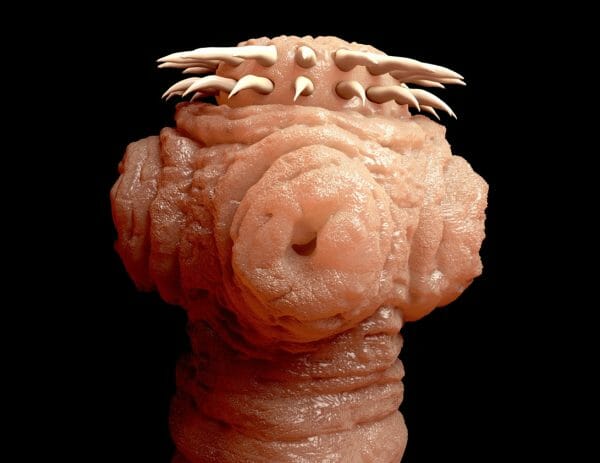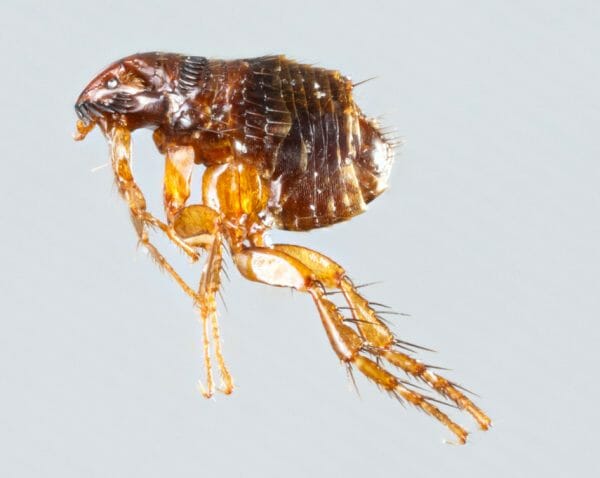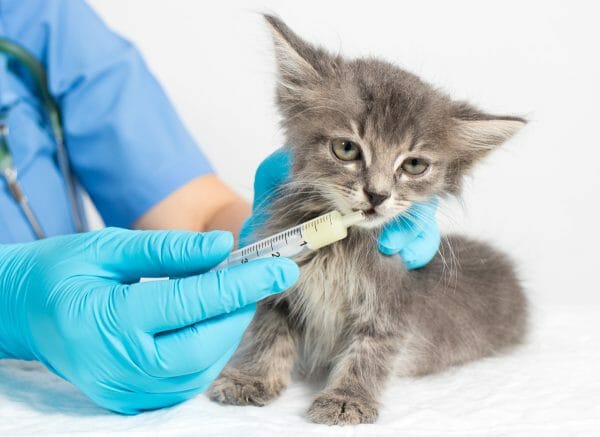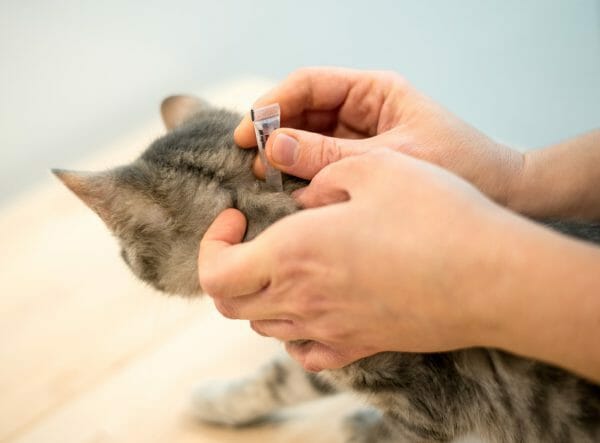Tapeworm Life Cycle in Cats
A tapeworm in cats is a flat intestinal parasite. The most common species is called Dipylidium caninum. In addition, two other species of tapeworm that can infect felines are Taenia and Echinococcus. The tapeworm has a hook-like mouth that it uses to anchor to the wall of the cat’s small intestine. Once matured, this type of worm will grow up to 11 inches in length. Some species that affect whales have been known to grow up to 100 feet.
During its time in the small intestine, the tapeworm will absorb nutrients from the gut of the cat. Once the worm reaches maturity, segments known as proglottids will break off, and the cat will pass these in its feces. These small pieces look much like cucumber seeds or grains of rice.
Sometimes, it is possible to observe tapeworm proglottids moving around the cat’s anus or on the surface of its feces. Once the proglottid starts to dry, it will turn into a golden color and will break open. After opening, the proglottid will release fertilized eggs. A single proglottid can hold up to 20 tapeworm eggs.

How Do Cats Get Tapeworms?
In the case of Dipylidium caninum, a flea will be required to complete the tapeworm’s life cycle. Initially, a tapeworm egg will be ingested by a flea while it is in the immature larva stage. Once the worm is inside the larval flea, it will grow until the flea reaches maturity.
This flea will then be swallowed by a cat, either following a bite or during grooming. Once inside the cat’s intestine, the flea is digested, and the egg of the tapeworm will be released. The egg will then hatch, and the tapeworm will cling to the lining of the intestine.
Tapeworms differ from other intestinal parasites in that they must pass through an intermediary host (such as a flea) before infecting a cat. Similarly, a cat may also ingest the Taenia or Echinococcus tapeworm via an infected mouse, bird, rabbit, or squirrel.

Tapeworm Symptoms in Cats
There are several signs of tapeworm in cats to look out for. The first place that signs may manifest will be in the cat’s feces, particularly when it is fresh. If the feces have small cream grains, then the feline is likely to be infected with the parasite.
A cat that frequently licks its own anus may be doing so to relieve the itching caused by a tapeworm. The cat may also bite or scratch in the same area either with its paws or by dragging its hind legs to remove any segments of the tapeworm that have migrated to the anus.
These parasites are also known to cause weight loss. This may occur despite an increase in the cat’s appetite.
Finally, check the coat of the cat. The presence of this parasite will cause the coat to become dull and shabby.
Additional Symptoms of Tapeworms
- Changes in appetite
- Vomiting
- Irritability
- Mild diarrhea
- Seizures
- Intestinal blockages
Some of these symptoms may also be indicators of other conditions, such as pancreatitis, feline panleukopenia, and feline leukemia.
In very rare cases, a condition called Haw’s syndrome may occur when there is a heavy infestation This causes prolapse of the third eyelid and is most common in dehydrated animals.

How to Diagnose Tapeworm in Cats
Usually, an owner identifies the presence of tapeworms by observing proglottids on the cat’s feces, in vomit, or on the anus. If identified early and the support of a veterinarian is sought, these parasites are easily treated. If there is any doubt about the diagnosis, the veterinarian will order a feces test. This test will look for the presence of bacteria, proglottids, and eggs in the fecal matter.
How to Treat Tapeworm in Cats
The most effective tapeworm medicine for cats is praziquantel. This can be administered topically or as a tablet or an injection. Just one dose is all that will be required to kill an adult worm. However, a second dose is recommended two weeks later to ensure there are no new tapeworms that have developed. Brand name versions of the medicine include:
- Bayer Tapeworm Dewormer Tablets for Cats: a non-prescription praziquantel tablet
- Bayer Drontal Tablets: can be used to treat tapeworm, hookworm, and roundworm; available only by prescription
- Bayer Droncit: an injection that needs to be administered by a veterinarian
Once the medication has been administered, the tapeworm will usually dissolve inside the cat’s intestine. There is not usually any visual sign of the parasite being expelled in the cat’s feces unless there has been a very high worm load.

What Happens If Tapeworms Go Untreated in Cats?
If left untreated, a tapeworm infection could cause weight loss, diarrhea, and vomiting. Kittens and older adult felines will be most susceptible to the negative effects of tapeworm and intestinal obstructions may occur. In older felines, the intestinal tract may become inflamed leading to chronic weight loss and vomiting.
How to Prevent Tapeworm in Cats
It is important to put preventative measures in place to minimize the risk of tapeworms. This can be done by providing monthly preventative treatment from the age of six weeks until six months. Once a cat reaches six months of age, this treatment can be administered every three months.
Cats that are known to hunt may need to be treated for intestinal parasites on a more regular basis. Providing an environment that is free from fleas will also reduce the chance of exposure to this parasite. Because ingesting an infected flea is the main cause of tapeworm in cats, using a monthly spot treatment to prevent fleas is essential. Other measures that can be taken include using oral flea medications and wearing a flea collar.

Can Tapeworms Be Passed from Cat to Human?
Because the most common tapeworm in cats is Dipylidium caninum (which is transmitted through fleas), there is little risk to humans as the likelihood of accidentally ingesting an infected flea is low. However, humans are at greater risk of being affected by other types of tapeworms as transmission may occur through undercooked meat or soil. Other types of parasitic infections that can affect felines include ringworm and heartworm.



